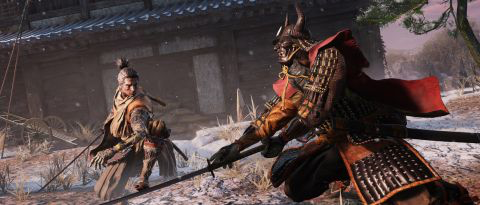CAMERON HENDERSON WRITES — The Japanese video game company “FromSoftware” released the much anticipated Sekiro: Shadows Die Twice March 22, 2019. This action-adventure video is for users of Microsoft Windows, PlayStation 4, and Xbox One.
Sekiro: Shadows Die Twice, which is in single-player, third-person format, calls for logic, creativity, and tremendous gaming skills. To win, players have to carve their own path to revenge in a fantasy game that follows this narrative: A disgraced and disfigured warrior, rescued from the brink of death, is pursued by a one-armed wolf sworn to protect him. The warrior is, in fact, a young lord, the descendant of an ancient bloodline whose lineage subjects him to many vicious enemies, including the dangerous Ashina clan. When he is captured and the wolf fails to protect him, the wolf embarks on a long and dangerous mission to regain honor and the one he promised to keep safe.
Sekiro: Shadows Die Twice features tough gameplay centering on combat. It introduces landscapes rife with intricate castles and unique, horrific one- of- a -kind enemies. The game takes place in late 1500s Sengoku Japan, a real-life period which was rife with such fierce conflict. So the game’s appeal is two-fold: The “fun” and excitement of violent play and the thrill of challenge that could leave to triumphant success. But new fans of souls games, beware: you will not complete “Sekiro” in a couple of sittings. ( For those who don’t know better, the “Souls games” name comes from the video game series “Dark Souls,” which is notorious in the gaming community for being the hardest but most rewarding to play). This predecessor to Sekiro is based in medieval times and has a very minimalist plot so that the protagonist is thrown into the game with no idea where to go or what to do. Such open world gameplay presents endless possibilities. He who finally wins will feel great enemy or boss satisfaction. One article explains the physiological phenomenon behind all this: the accomplishment of hard tasks stimulates the brain to produce dopamine, which in turn ignites feelings of pride and gratification.
And yet, some say Sekiro actually has some forgiving mechanics that make it a little easier for players. Other Souls games, for example, have nothing remotely close to a “revive mechanic” by which the character can be resurrected from where it last played. Also, unlike previous games, every boss had to learn attack patterns, dodge said attacks, and to strike whenever windows were open. Allowing the character to adjust its posture in this way creates an opportunity for players to slowly break down enemies with perfectly timed parries that can accumulate into a massive single blow.
Sekiro topped its competitors the week of its release, outselling big names such as “Division 2,” the third person shooter game, as well as “Fifa 19,” a globally played soccer game. It in fact sold over 150 thousand copies within three days of release. It has also received high praise from the three big gaming hubs, with a 90% from Metacritic, a 4 out of 5 from GamesRadar and a 9.5 from IGN.
Who knows where the game will go after content creators from Youtube and Twitch give their own thoughts? Will the Sekira sensation last long enough, and be big enough, to justify a sequel, thus expanding the overall future of its developer Fromsoftware? These are the platforms that ultimately make or break video games.




Thank you. These are the platforms that ultimately make or break video games. it is really? https://pconeri.com